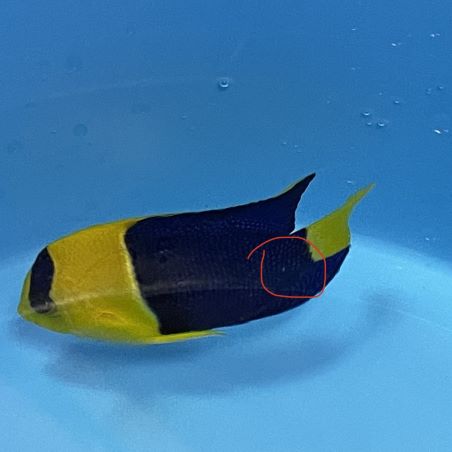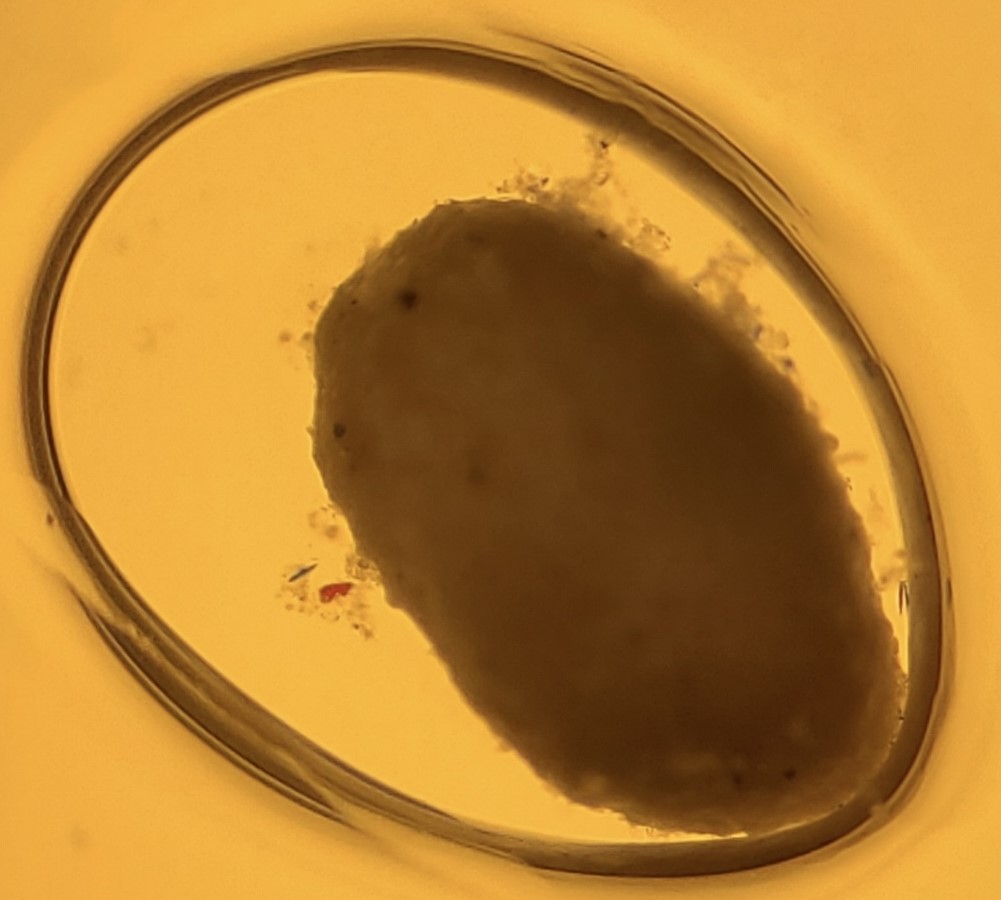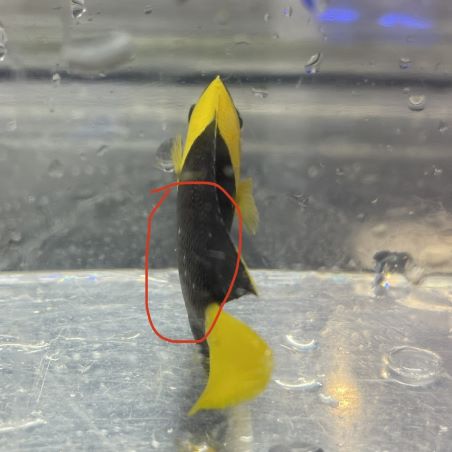Jump to:
- Introduction to Flukes
- Symptoms
- Treatment
- Bicolor Angelfish part 1
- Bicolor Angelfish part 2
- Conclusion
- References
Introduction to Flukes
A fluke is in the subclass Monogenea, and is a parasitic worm that harms fish. A fluke will attach itself to a fish’s gills, skin, or eyes by hooks in their mouth. Once the fluke has attached to a fish, it will feed off it, creating holes in the fish that can be susceptible to secondary infections. Butterflyfish and Angelfish are more susceptible to flukes.. Other types of fish can get it, though it is less likely. The fluke parasite looks like a physical bubble on the fish. specimen, and can cause many other effects to occur.
Symptoms
There are many symptoms accompanied with a parasitic infection of a fluke. For example, they can cause the fish to have cloudy eyes, swim towards the surface, hide in rocks or in the corner of the aquarium, and more. Another important symptom for flukes is darting around and scratching in the tank. This is because the fish is trying to move and scratch to get the flukes off them. If the flukes are attached to the fish’s gills, it will cause the fish to breathe rapidly because the parasite is blocking their airway. One of the last symptoms of flukes is their loss of appetite. This is because the fluke is attached to the fish, taking the nutrition from it.
Treatment
The first step to treat flukes is to dip the fish for five to ten minutes in freshwater. This freshwater dip will cause some or all of the flukes to come off the fish because the salinity of freshwater is 1.005 ppt (parts per thousand), while saltwater fish are accustomed to 1.018-1.025 ppt. Putting a saltwater fish with flukes in freshwater will kill some or all of the flukes that are on the fish,causing the flukes to come off and float in the water, but it will not kill the fish being in freshwater for 5-10 minutes. These freshwater dips can be done to the fish on a daily basis if flukes are still being found. If a fish has flukes, the fish cannot be placed in the same tank because the fluke eggs are still in that original tank. The tank will need to be drained and cleaned, and any other fish in the same tank with the one that has flukes will need to be placed in a different tank to prevent the spread of flukes. Once the fish with flukes is in a new, clean tank, it will be medicated with Prazipro, which is a medication to treat flukes and other worms.
Bicolor Angelfish Part 1
Picture 1 & 2
The first Bicolor Angelfish (Picture 1) was originally in the medication of Chloroquine Phosphate and Methylene Blue for Ich, but this medication was not working and the small dot in the blue/black region at the end of the fish near the caudal fin circled in red is a fluke. The flukes could have come from the wholesaler the Bicolor Angel (Picture 1) came from, or it could have come from the other fish that were in the tank with the Angelfish (Picture 1). Less than a week after the fish arrived at our store, the fish had a fluke attached to it. After this observation, the quarantine team netted the fish, and gave it a freshwater dip. In this picture, the Angelfish (Picture 1) was placed in a small bucket with freshwater, and some flukes did come off. The quarantine team sampled what came off the fish, and placed it on a slide under the microscope (Picture 2). The other fish in with the Bicolor Angelfish (Picture 1) were moved to a different tank to prevent the spread of the flukes. The Bicolor (Picture 1) was placed in a new, clean tank with Prazipro, which is a medication to treat flukes and other worms. The Angelfish (Picture 1) got another freshwater dip three days later, and started to develop a dark color on its face and passed away. The cause of the dark color appearing on its face is unknown, but because of the holes the flukes had made on the skin of the Bicolor Angel (Picture 1), it is likely that the fish developed a bacterial infection, which would explain the dark patches on the fish’s face.
Bicolor Angelfish Part 2
Picture 3
The second Bicolor Angelfish (Picture 3) was from a new batch of fish that came from a wholesaler, and had a fluke outbreak as shown circled in red. This Bicolor Angelfish (Picture 3) was pulled from the salt water system it was in, and was given a freshwater dip for seven minutes. During this time, a new tank in quarantine was medicated with Prazipro, and after the 7 minute freshwater drip, the Angelfish (Picture 3) was placed in the Prazipro tank. Over the course of the next few days, this Angelfish (Picture 3) got another freshwater dip, and it passed away. Part of its body looks like it had been missing scales, which would be explained from the holes the flukes put in the fish. Our quarantine team noticed it looked like the Angelfish (Picture 3) has not been eating, which is a symptom of flukes.
Conclusion
A fluke is a harmful parasite to fish that takes a fish’s nutrients and can ultimately kill a fish. A fluke can choose many places on the fish to attach with their mouth hooks called a haptor, such as their gills, eyes, or skin. Once the fluke attaches to a fish, it creates holes which can later develop into a secondary infection that can also kill the fish. Be careful what fish you have in your tank because Butterflyfish and Angelfish are the most susceptible to flukes, and it can spread in your aquarium, potentially harming other fish. The most common symptom for flukes is the physical appearance of a small gray bubble. Other symptoms include swimming towards the surface, cloudy eyes, hiding in rocks or in a corner, loss of appetite, rapid and heavy breathing, and more. It is important to act fast when seeing these symptoms, and dipping the affected fish in freshwater, followed by Prazipro. Our research is ongoing, we will continue to publish research papers in accordance with our commitment to make the quality of marine life better here at Salty Underground. While working with these fish, we have not been successful in our research.The treatment we're giving the fish is correct, but we will need to keep trying for success.
By: Sarah Cooley
References
Goemans, Bob, et al. 2008, The Marine Fish Health & Feeding Handbook: The Essential Guide to Keeping Saltwater Species Alive and Thriving. Microcosm/T.F.H. Publications, retrieved [July 20].
User Humblefish. “Flukes – General Guidelines.” REEF2REEF Saltwater and Reef Aquarium Forum, REEF2REEF Saltwater and Reef Aquarium Forum, retrieved [July 18,2022] available online at https://www.reef2reef.com/threads/flukes-%E2%80%93-general-guidelines.224423/
User melypr1985. “Fish Disease Index - Pictorial Guide.” REEF2REEF Saltwater and Reef Aquarium Forum, retrieved [July 11, 2022] available online at https://www.reef2reef.com/ams/fish-disease-index-pictorial-guide.199/



